PC Chips (Hsing Tech Enterprise Co.) was a low-end motherboard manufacturer for the IBM PC and its compatibles during the DOS era. Founded in 1984, they later became one of the major shareholders in Elitegroup (ECS) in 1998 and finally merged with ECS in 2005.
The were somewhat famous in the mid 90s to early 2000s for building motherboards with fake cache chips on 486 boards, including modified BIOS to show the presence of a cache when there wasn't one, and relabelled chipsets (socket 5, 7 and slot 1) suggesting they were better than Intel's.
M326
Year: 1993
Type: 80386DX
Form Factor: Baby AT
Power Connector: AT
Chipset: SARC RC4018A4
Slots: 5 x ISA (16-bit), 1 x ISA (8-bit)
Memory: 8 x 30-pin SIMM (2 banks) + onboard cache
BIOS: Award v4.50
BIOS IDs:
08/10/93-UMC-491-214X2002-00
Known Revisions: 3.1
The blue socket in the corner is for a math coprocessor. Another revision of this board has a socket for the main CPU instead of the PQFP (Plastic Quad Flat Package) you see in the rev 3.1 image above. Socketed versions support the Cyrix Cx486DLC or Texas Instruments TX486DLC chips.
Here is an example of a board revision with a CPU socket: 1 2 3 4 |
M396F
Year: 1993
Type: 80386SX / CX486SLC
Form Factor: Baby AT
Power Connector: AT
Chipset: SARC RC4018A4
Slots: 6 x ISA (16-bit)
Memory: 4 x 30-pin SIMM (2 banks) - max 16 MB.
BIOS: American Megatrends Inc.
BIOS IDs:
Known Revisions: 2.2, 3.0
This board supports CPU speeds of 16, 25, 33 and 40 MHz. Both the Intel 80386SX and Cyrix Cx486SLC are supported.
Version 2.2 of this board may have a PC Chips-branded single-chip controller with CHTF2 on it, instead of the SARC RC4018A4.
User Guide
|
M507 / Elpina M507 / Amptron PM7600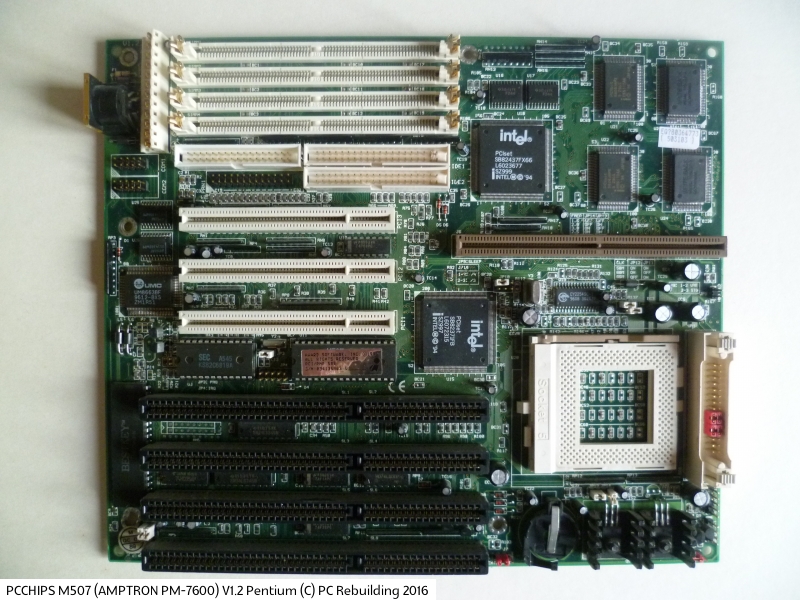
Year: 1996
Type: Socket 5
Form Factor: Baby AT
Power Connector: AT
Chipset: Intel 430FX Triton I
Slots: 4 x ISA (16-bit), 3 x PCI, 1 x COAST
Memory: 4 x 72-pin SIMM (2 banks) - max 128 MB onboard.
BIOS: Award (unknown ver) -
BIOS IDs:
07/31/95-TRITON-2A59CF54C-00
01/05/96-i430fx-2A59CF54C-00
Known Revisions:
1.1, 1.2
Supports single-rail voltage CPUs, including the Intel Pentium P54C 75 MHz up to 200 MHz, AMD K5 PR75 - PR166, IDT C6/Winchip 2/2A and some early Cyrix 6x86 including P120+, P150+ and P166+. In order to support dual-rail voltage CPUs (such as Pentium P55C), you must also have the PCChips voltage regulator module (VRM) installed which was an optional extra.
External bus clock speeds supported are: 50 MHz, 60 MHz and 66 MHz.
Clock speeds supported are 1.5x, 2.0x, 2.5x and 3x.
This is one of the PC Chips boards that have the fake cache chips, as can be seen in the top-right corner of the image above - this means that unless you have a COASt module installed in the slot, the motherboard has no L2 cache. Either a 256 KB or 512 KB module of asynchronous SRAM or a 256 KB module of pipeline-burst SRAM can be installed. The board can support a cacheable area up to 64 KB of cache.
The SIMM memory banks support both EDO (Extended Data Out) and Fast Page Mode (FPM) DRAM modules.
All three PCI slots support bus mastering, with support for up to 4 IDE drives in PIO Mode 0 up to Mode 4 (max. transfer rate of 16.67 MB/second) and master DMA Mode 2 for a maximum of 22 MB/second. Hard disks of between 528 MB and 8.4 GB are supported without device drivers.
User manual
Jumper Settings
|
M519
Year: 1995
Type:
Form Factor:
Chipset: OPTi Viper-M
Slots:
Memory:
BIOS: |
M520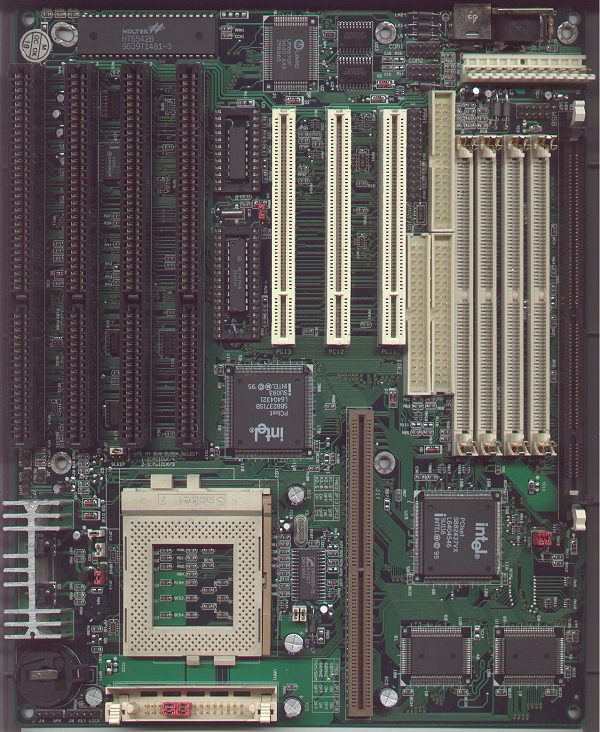
Year: 1996
Type: Socket 7
Form Factor:
Chipset: Intel 430VX
Slots: ISA (4x16-bit), PCI (3)
Memory: 4 x 72-pin SIMM (8 to 128 MB max), 1 x 168-pin DIMM (8 to 64 MB max.)
BIOS:
Award
BIOS IDs:
08/26/96-i430VX-2A59Ht5BC-00
Known Revisions: v1.0
This board has 256 KB or 512 KB COAST 3.0+ module slot.
It supports 3.3V and 3.5V CPUs, with multipliers of 1.5x, 2x, 2.5x or 3x. CPU support is as follows: Pentium P54C-75/90/100/120/133/166/180/200 MHz, Pentium P55C (optional voltage regulator module required), Cyrix/IBM 6x86 P120+/P150+/P166+, and AMD K5 PR75-PR166.
FSB speeds are 50, 60 or 66 MHz.
The last BIOS version for this board was dated 09/16/1997, and added support for AMD K5 PR166 and AMD K6 CPU, Cyrix MII CPU, LBA mode (> 512 MB), and auto-banking DRAM. Older BIOS versions were dated 07/02/1996, 08/31/1996, 10/20/1996, and 03/03/1997.
|
M537 / Amptron PM8400A/B
Year: 1997
Type: Socket 7
Form Factor:
Chipset: VIA Apollo VP1 (relabelled "VX Pro").
Slots: 3 x ISA (16-bit), 4 x PCI
Memory: 4 x 72-pin SIMM (2 banks), 2 x 168-pin DIMM.
BIOS: Award
BIOS IDs:
08/15/97-VXPro-UMC8670-2A5LAH09C-00
08/14/97-vxpro+ -usb-ultra 2A5LDH09C-00
Known Revisions:
1.2, 3.1, 5.1.
The Apollo VP1 chipset can only handle 16 Mbit memory modules - those with 64 Mbit will only be recognised at a quarter of their true capacity. So you need to choose either: 8x16M, 16x32M, or 32x64M.
The board supports FSB speeds of 50, 55, 60, 66, and 75 MHz, and CPU clock multipliers of 1.5x, 2.0x, 2.5x, and 3.0x. CPU core voltages supported are 2.5V, 2.7V, 2.8V, 2.9V and 3.5V. Compatible CPUs are Pentium 75-233, P54C, P55C MMX, Cyrix/IBM 6x86MX (MII), IDT C6, and AMD K5 and K6.
The 72-pin SIMM slots provide for between 8 MB and 256 MB of either FPM of EDO 60ns DRAM. The 168-pin DIMM slots can be fitted with 16Mx4, 8Mx8 or 4Mx16 66ns SDRAM modules.
IDE ports work in either PIO Modes 0 through 4.
It appears to have a 512 KB L2 cache, although despite the BIOS message on boot-up, the external L2 cache on these boards is fake.
The M537 is not able to handle FSB speeds above 66 MHz without overclocking the PCI bus. The later M537DMA33 has this ability.
Revision 1.2 has a linear voltage regulator, rev 5.1 has a switching voltage regulator.
The board has a USB port header, but it doesn't work because this was the early days of USB before the specification had been ironed out. The port is permanently disabled in the BIOS as a result.
This motherboard often had its chipset relabelled to "VX Pro", but is in fact a VIA Apollo VP1.
User manual
Unofficial Info
BIOS Versions
Amptron PM8400 Specs
BIOS Update - dated 09/04/97
BIOS Update - dated 02/19/98
Amptron PM8400 BIOS Update - dated 12/03/97
|
M537DMA33 / Amptron PM8400C/D / Ability MB-586VX7+, Matsonic MS-5120
Year: ?
Type: Socket 7
Form Factor:
Chipset: VIA Apollo VPX.
Slots: 3 x ISA (16-bit), 4 x PCI
Memory: 4 x 72-pin SIMM (2 banks), 2 x 168-pin DIMM.
BIOS: Award
BIOS IDs:
08/14/97-VXPro+-USB-Ultr-2A5LDHO9C-00
Known Revisions: 5.2.
The M537DMA33 was able to handle FSB speeds above 66 MHz without overclocking the PCI bus. The earlier M537 was not.
This motherboard often had its chipset relabelled to "VX Pro+", but is in fact a VIA Apollo VPX.
Almost everything else about the M537DMA33 is identical to the M537 (see above). The M537DMA33 was also sold as Sybercom MB537DMA(VXpro+), Ability MB-586VX7+, Protac MB5370+, Eurone EM-5800V+ v5.2A, Matsonic MS-5120, Aristo AM-538VXPLUS(?), and Pine PT7504-AB. They are identical in every way to the PCChips M537DMA33.
User manual and BIOS
|
M539
Year: ?
Type:
Form Factor: Baby AT
Chipset: ALi Aladdin III
Slots: ISA (3x16-bit), PCI (4)
Memory: 4 x 72-pin SIMM, 2 x 168-pin DIMM.
BIOS: AMI
BIOS IDs:
51-0300-000000-00111111-071595-HX PRO-H
51-0625-001437-00111111-071595-HXPRO-001-10-ADD3-H
This motherboard often had its chipset relabelled to "HX Pro", but is in fact an ALi M1521 (Aladdin III).
The board supports FSB speeds of 50, 55, 60, 66, and 75 MHz, and CPU clock multipliers of 1.5x, 2.0x, 2.5x, and 3.0x. CPU core voltages supported are 2.5V, 2.7V, 2.8V, 2.9V and 3.5V. Compatible CPUs are Pentium 75-233, P54C, P55C MMX, Cyrix/IBM 6x86MX (MII), IDT C6, and AMD K5 and K6.
The 72-pin SIMM slots cater for between 8 and 256 MB of either FPM or EDO 60ns DRAM, whilst the 168-pin DIMM slots can be fitted with 16Mx4, 8Mx8, or 4Mx16 66ns SDRAM.
|
M547 / Matsonic MS-5120
Year: ?
Type: Socket 7
Form Factor: Baby AT
Chipset: VIA Apollo VPX.
BIOS: Award
BIOS IDs:
08/14/97-VXPro+-USB-Ultr-2A5LDH09C-00
04/30/98-537+UMC8670F-2A5LDH09C-00
Revisions: v5.2A
This motherboard often had its chipset relabelled to "VX Pro+", but is in fact a VIA Apollo VPX. The "H0" in the BIOS string stands for Hsing Tech, PCChips' actual company name.
User manual
|
M558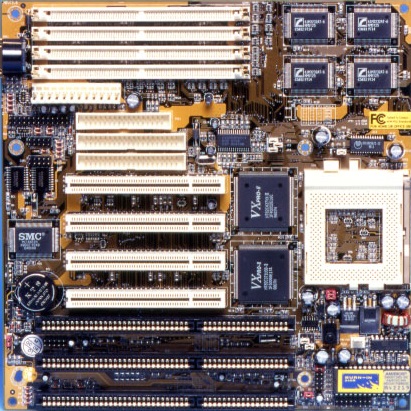
Year: ?
Type: Socket 7
Form Factor: Baby AT
Chipset: Ultron UT801X.
Slots: ISA (3x16-bit), PCI (4)
Memory: 4 x 72-pin SIMM.
This motherboard often had its chipset relabelled to "VX Pro II", but is in fact an Ultron (aka Hintcorp) UT801X. The chipset does NOT support UDMA or ACPI.
The board has either 256 KB or 512 KB of L2 cache, supports CPUs ranging from Pentium 75-233, P54C, P55C MMX, Cyrix/IBM 6x86MX (MII), IDT C6, and AMD K5 and K6. It can run the FSB at 50,60,66, and 75 MHz.
The M558 differs from the M559 in that it does not come with onboard sound and only has the older SIMM memory slots. It was also sold as the Eurone EM-5558.
User manual
|
M559
Year: ?
Type: Socket 7
Form Factor: Baby AT
Chipset: Ultron UT801X.
Slots: ISA (2x16-bit), PCI (4)
Memory: 4 x 72-pin SIMM, 2 x 168-pin DIMM.
BIOS: AMI
BIOS IDs:
51-1213-001437-00111110-071595-UT801X-001_10_UTRON-F
51-0122-001437-00111111-071595-UT801X-001_10_UTRON-F
51-0309-001437-00111111-071595-UT801X-001_10_UTRON-F
This motherboard often had its chipset relabelled to "VX Pro II", but is in fact an Ultron (aka Hintcorp) UT801X. The chipset does NOT support UDMA or ACPI. The "1437" in the AMI BIOS string indicates the board is by Hsing Tech, PCChips' actual company name.
The board has a 512 KB L2 cache.
Core voltage only goes as low as 2.5V, so this board is unable to run AMD K6-2 CPUs. It can support Pentium P54C 75 to 233 MHz, P55C (Pentium MMX), Cyrix/IBM 6x86MII, IDT C6 and AMD K5 and K6 CPUs. FSB speeds are 50, 60, 66 or 75 MHz.
The M559 differs from the M558 in that it comes with onboard sound (Aureal Vortex 1/A3D?) and has DIMM slots. It was also sold as the Eurone EM-5559.
The board cannot handle 3.3V SDRAM. The DIMM slots are for 5V modules only.
User manual
|
M560 / Amptron PM8500 / M560TG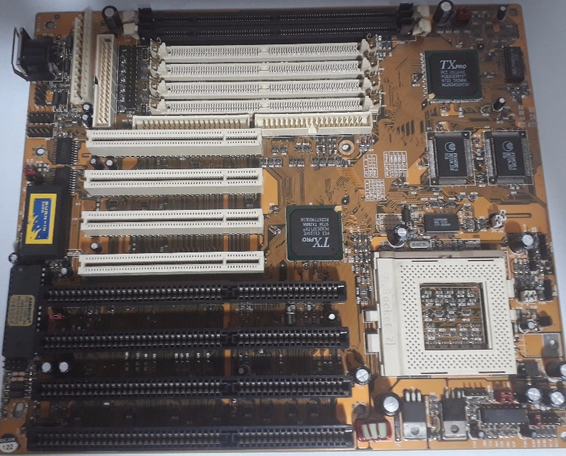
Year: 1998
Type: Socket 7
Form Factor: Baby AT
Power Connector(s): AT
Keyboard Connector: AT
Chipset: ALi Aladdin IV+
Slots: ISA (2x16-bit), PCI (4)
Memory: 4 x 72-pin SIMM, 2 x 168-pin DIMM.
BIOS: AMI
BIOS IDs:
51-0201-001437-00111111-071595-M1531/43-001_10-H (M560 v4.1A model)
51-0505-001437-00111111-071595-M1531/43-001_10_TX_PRO-0 (M560 model)
51-0505-001437-00111111-071595-M1531/43-001_10_TX_PRO-H (M560TG model)
Known Revisions: 3.1, 3.1A, 4.1, 4.1A
Don't necessarily be put off by PC Chips motherboards - generally they are poorly-made with thin PCBs, but the M560 benchmarks as one of the fastest Socket 7 mainboards you could get.
CPU support: Pentium P54C 75 to 233 MHz, P55C (Pentium MMX), Cyrix/IBM 6x86MII, IDT C6 and AMD K5 and K6 CPUs.
This motherboard often had its chipset relabelled to "TX Pro", but is in fact an ALi M1531 (Aladdin IV+).
The SIMM slots support between 8MB and 256 MB of either FPM or EDO 60ns DRAM. The DIMM slots can be filled with 8 MB, 16 MB, 32 MB, 64 MB or 128 MB of PC-66 or PC-100 SDRAM modules.
The board comes with either 512 KB or 1 MB of pipelined-burst synchronous L2 cache.
Board revision 4.1 added support for 50 and 55 MHz FSB speeds. These were missing on the 3.1 and 3.1A revisions. 3.1A uses a replaceable Lithium-Ion CR2032 battery coin cell. 3.1 used a RTC chip. 3.1A also fixed a small hardware issue related to the HDD LEDs.
The M560TG had 5 PCI slots - the M560 only had 4.
The M560TG was also sold under the name Eurone EM-5560TG.
User manual (v3.1), User manual (v4.1 German), M560TG User manual (same as M565)
|
M565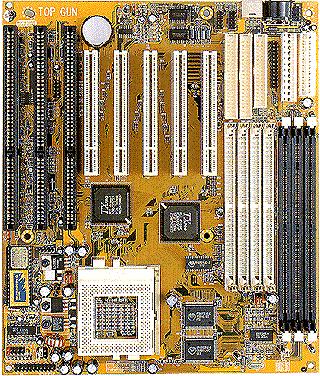
Year: ?
Type: Socket 7
Form Factor: Baby AT
Chipset: ALi Aladdin IV+
Slots: ISA (2x16-bit), PCI (4)
Memory: 4 x 72-pin SIMM, 2 x 168-pin DIMM.
BIOS: AMI
BIOS IDs:
51-0505-001437-00111111-071595-M1531/43-001_10_-H
51-0505-001437-00111111-071595-M1531/43-001_10_TX_PRO-H
Known Revisions: v1.2
This motherboard often had its chipset relabelled to "TX Pro", but is in fact an ALi M1531 (Aladdin IV+).
Four BIOS versions are known. The 1126S.rom removes the "TX Pro" text from the BIOS string. 0214s.rom added support for Cyrix 6x86MX (MII) 266 MHz, resolved an issue with formatting SCSI hard disks and a hang-up on COM port 2. Version 0410s.rom added support for hard disks over 8.4 GB and also added Trend's Chipaway ROM. Finally version 0624s.rom fixed a problem when using Cyrix 6x86MX (MII) and booting from a ZIP drive on the ATAPI interface.
This board came with 1024 KB of L2 cache onboard. It was also sold under the name Eurone EM-5565.
User manual
|
M567
Year: 1998
Type: Socket 7
Form Factor: Baby AT
Chipset: SiS 5598.
Slots: ISA (4x16-bit), PCI (4)
Memory: 4 x 72-pin SIMM, 2 x 168-pin DIMM.
BIOS: AMI
BIOS IDs:
51-0928-001437-00111111-071595-TXPROII-007_66_TXPROII-H
51-1120-001437-00111111-071595-TXPROII_007_66_TXPROII-H
This motherboard often had its chipset relabelled to "TX Pro II", but is in fact an SiS 5598.
CPU support: Pentium P54C 75 to 233 MHz, P55C (Pentium MMX), Cyrix/IBM 6x86MII, IDT C6 and AMD K5 and K6 CPUs.
SIMM slots support memory from 8 MB up to 384 MB of either FPM or EDO 60ns DRAM. The DIMM slots can be fitted with either 16Mx4, 8Mx8 or 4Mx16 of PC-66 or PC-100 SDRAM modules.
The M567 came with an onboard 64-bit graphics accelerator with 4 MB of dedicated video RAM and "3D Sound Pro" chip onboard, which is a rebranded C-Media CMI8330.
User manual
|
M570 / Amptron PM9700
Year: 1998
Type: Socket 7
Form Factor: Baby AT
Chipset: SiS 5591
Slots: 2 x 16-bit ISA, 3 x PCI, AGP
BIOS: AMI
BIOS IDs:
51-0731-001437-00101111-071595-570-01_10_CHIPSET-H
Known Revisions: 1.3
This motherboard often had its chipset relabelled to "Super TX4", "TX AGP Pro" or "TX Pro IV", but is in fact an SiS 5591.
CPU support: Pentium P54C 90 to 300 MHz, P55C (Pentium MMX), Cyrix/IBM 6x86MII, IDT C6 and AMD K5 and K6 CPUs. FSB speeds are 60, 66, 75 and 83 MHz.
SIMM slots support memory from 8 MB up to 640 MB of either FPM or EDO 60ns DRAM. The DIMM slots can be fitted with either 16Mx4, 8Mx8 or 4Mx16 of PC-66 SDRAM modules.
It came with 1024 KB of L2 cache onboard, and "3D Sound Pro", which might be an Aureal Vortex 1/A3D-capable chip.
User manual
|
M571 / Amptron PM9100 / M571LMR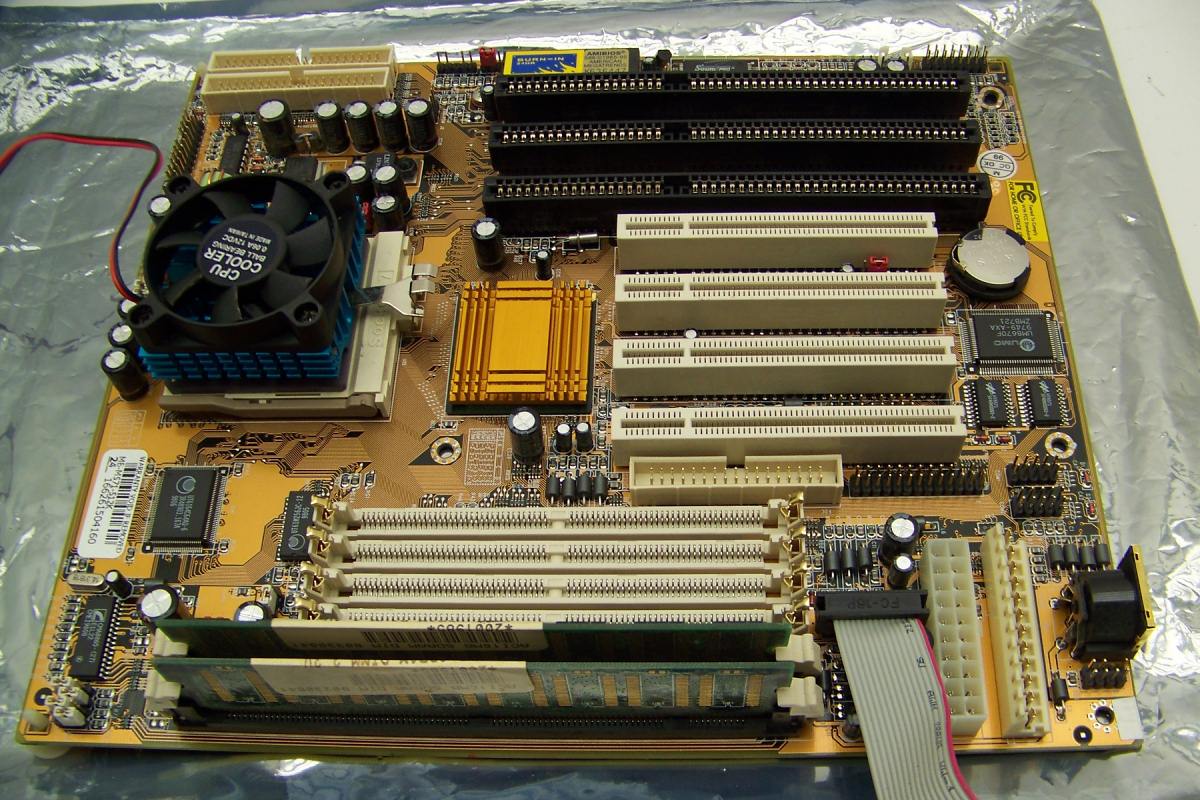
Year: ?
Type: Socket 7
Form Factor: Baby AT
Chipset: SiS 5598
Slots: 3 x 16-bit ISA, 4 x PCI v1.0 (M571)
2 x 16-bit ISA, 3 x PCI (M571 LMR)
Memory: 4 x 72-pin SIMM slots, 2 x 168-pin DIMM slots.
Power Connector: AT and ATX
BIOS: AMI
BIOS IDs:
51-0224-001437-00111111-071595-571-007_66_571-H
51-0305-001437-00101111-071595-M571-007_66_M571-H
51-0421-001437-00101111-071595-M571-007_66_M571-H
51-0506-001437-00101111-071595-M571-007_66_M571-H
51-1227-001437-00111111-071595-571-007_66_571-H
51-0702-001437-00101111-071595-M571-007_66_M571-H (LMR version)
Known Revisions: 3.2a
This motherboard often had its chipset relabelled to "Super TX3" or "TX Pro II", but is in fact an SiS 5598. It supports Pentium P54C 75 to 266 MHz, P55C (Pentium MMX), Cyrix/IBM 6x86MX (M-II), IDT Winchip C6, and AMD K5 and K6 CPUs (including K6-2+ and K6-3+). FSB speeds are 50, 60, 66 and 75 MHz. The board has 512 KB of L2 cache onboard.
On the non-LMR version, the 72-pin SIMM slots support memory from 8 MB up to 512 MB of either FPM or EDO 60ns DRAM. The DIMM slots (fitted to both non-LMR and LMR versions) can be fitted with either 16Mx4, 8Mx8 or 4Mx16 of PC-66 or PC-100 SDRAM modules.
The M571 came with an onboard 64-bit graphics accelerator with 4 MB of dedicated video RAM and "3D Sound Pro" chip onboard (Aureal Vortex 1/A3D?).
In addition, the M571LMR got these changes/additions:
- 2 ISA slots and 3 PCI v1.0 slots
- Onboard 56k fax/modem
- Onboard 10/100 Mbps Fast Ethernet LAN
- FSB clock speed of 83.3 MHz and dropped the 50 and 60 MHz options
- CPU support is now Intel Pentium P54C 90 - 450 MHz as well as AMD K6-2 and K6-3
- Same amount of L2 cache (512 KB)
Revision 3.2a of this board was apparently when PCChips first supported 2.2V CPU core voltage.
It was also sold under the name Eurone EM-5571.
User manual |
M573
Year:
Type: Socket 7
Form Factor: Baby AT
Chipset: VIA Apollo VPX.
Slots:
2 x 16-bit ISA, 4 x PCI
Memory: 4 x 72-pin SIMM slots, 2 x 168-pin DIMM slots.
BIOS: Award
BIOS IDs:
2/10/98-573 +ITE 866 IF- 2A5LDH09C-00
04/30/98-573+ITE8661F-2A5LDH09C-00 (different BIOS to the one used in the M537DMA33!)
Revisions: v3.1.
This motherboard often had its chipset relabelled to "TX Pro III", but is in fact a VIA Apollo VPX. The "H0" in the BIOS string stands for Hsing Tech, PCChips' actual company name.
CPU support: Pentium P54C 75 to 233 MHz, P55C (Pentium MMX), Cyrix/IBM 6x86MII, IDT C6 and AMD K5 and K6 CPUs. FSB speeds are 50, 60, 66, and 75 MHz.
SIMM slots support memory from 8 MB up to 384 MB of either FPM or EDO 60ns DRAM. The DIMM slots can be fitted with either 16Mx4, 8Mx8 or 4Mx16 of PC-66 or PC-100 SDRAM modules.
The M573 came with the "3D Sound Pro" chip onboard, which might be an Aureal Vortex 1/A3D chip.
User manual
|
M575 / Ability MB-586TXA1 "Top Gun"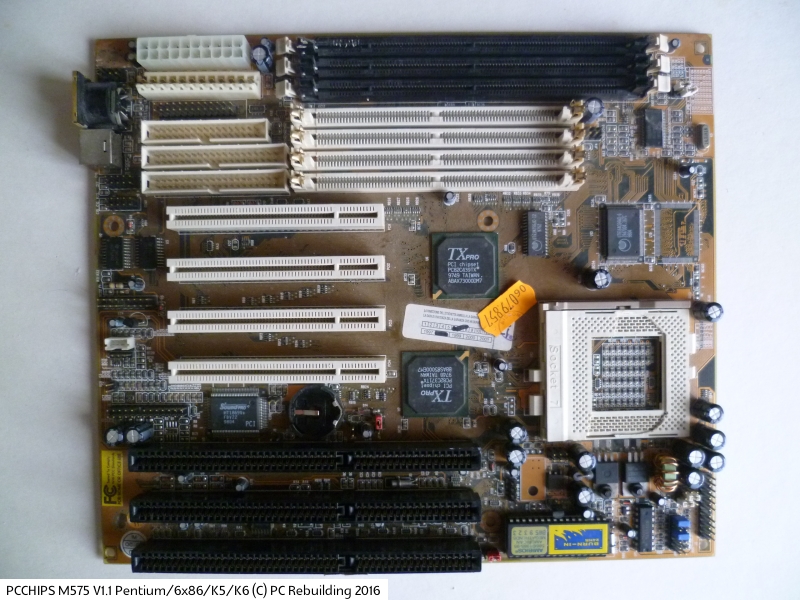
Year: 1995
Type: Socket 7
Form Factor: AT
Power Connector: AT and ATX
Chipset: ALi Aladdin IV+
Slots: 3 x ISA (16-bit), 4 x PCI
Memory: 4 x 72-pin SIMM (2 banks), 3 x 168-pin DIMM.
384 MB max.
BIOS: AMI WinBIOS
BIOS IDs:
51-0505-001437-00111111-071595-M1531/43-001_10_-H
51-0201-001437-00111111-071595-M1531/43-001_10_-H (also seen on M560 v4.1A board)
Known Revisions: 1.1, 1.2
This motherboard often had its chipset relabelled to "TX Pro", but is in fact an ALi M1531 (Aladdin IV+). Testing a AMD K6-2 / 400 2.2V core on the jumper groups JP5 and JP7 (the CPU can work in underclocking and overclocking and with FSB from 66 to 83MHz). With clock multiplier 2 and FSB 83MHz the AMD K6-2 / 500 can also be installed (the CXT processor core remaps from 2.0x to 6.0x).
Front Side Bus speeds from 50 MHz up to 83.3 MHz.
Level 2 cache onboard: 512 KB (user manuals state 1 MB ?) - believe you can get this board with either 512 KB or 1 MB of L2 cache.
CPU Support:
Intel Pentium 90-300, Cyrix/IBM 6x86 and 6x86MX, IDT C6, AMD K5 and K6.
CPU Clock Multipliers: 1.5x up to 5.5x.
SIMM slots support memory from 8 MB up to 384 MB of either FPM or EDO 60ns DRAM. The DIMM slots can be fitted with either 16Mx4, 8Mx8 or 4Mx16 of PC-66 or PC-100 SDRAM modules.
The M575 also comes with onboard sound (Aureal Vortex 1/A3D possibly).
User Manual (v1.1)
User manual (v1.2)
Jumper Settings
New CPU Jumper Settings |
M577 / Amptron PM9900
Year:
Type: Socket 7
Form Factor:
Chipset: VIA Apollo MVP3
Slots:
Memory: 3 x DIMM, 2 x SIMM (early models only).
Known Revisions: 3.0
Note that this motherboard's chipset is often relabelled "AGP Pro" or "PC-100", but underneath it's a VIA Apollo MVP3. This means you can use all the VIA drivers with this board.
The board support 100 MHz Front Side Bus speed, and comes with onboard sound (Aureal Vortex 1/A3D possibly) and 1 MB of L2 cache.
Supports AMD K6-2+ and K6-3+ CPUs.
User manual
|
M583LMR
Year:
Type: Socket 7
Form Factor:
Chipset: ALi Aladdin 7
Slots:
|
M585 / M585LMR
Year:
Type: Socket 7
Form Factor:
Chipset: VIA MVP4.
Slots:
This motherboard often had its chipset relabelled to "VIA GRA", but is in fact a VIA MVP4.
|
M587LMR
Year:
Type: Socket 7
Form Factor:
Chipset: ALi Aladdin 7
Slots:
|
M590
Year: 1998
Type: Super Socket 7
Form Factor: Micro-ATX
Chipset: SiS 5591.
BIOS: AMI
BIOS IDs:
51-0109-001437-00111111-071595-570-001_10_CHIPSET-H
In April 2023 I did a retro review of my PC Chips M590 motherboard.
CPU support: Intel Pentium 90 - 350 (P54C and P55C MMX), AMD K6, K6-2 (3.2V and 2.2V), Cyrix/IBM 6x86, 6x86L, 6x86MX/MII, and IDT C6.
Memory supported is both 72-pin SIMM (2 slots) and the later 168-pin DIMM (2 slots). The SIMM slots work with either FPM or EDO RAM up to 60ns. The DIMM slots provide a capacity of 4 MB up to 256 MB of PC-66/100 SDRAM.
The board has CPU "Plug & Play" feature where it auto-switches power from 2.2V up to 3.5V for CPU core voltage, making CPU installation much faster and less problematic.
This motherboard often had its chipset relabelled to "PC100" or "TX AGP_PRO", but is in fact
an SiS 5591. This is also found on M570.
Reports on the web also indicate that this motherboard has serious stability problems when trying to run FSB at 100 MHz, e.g. with an AMD K6-2 350 at 100 x 3.5 multiplier. Instead running it at 83.5 x 4.5 multiplier (375 MHz). Apparently the SiS chipset on this board is not rated for above 90 Mhz, and is very unstable even at that speed. When you set FSB to 95 MHz it actually runs it at 90 Mhz, which causes the stability problems, such as registry errors.
With the 1998/12/09 BIOS, K6-2 runs well. 400 MHz is reachable only as 6.0x66 MHz, which gives low L2 cache performance. A good fit is a 450 MHz type run at 6.0x75=450 or 5.5x83=456 MHz (best L2 cache speed, good performance, still stable). Your peripheral busses are at correct speeds in either mode (32 MHz PCI and IDE plus 64 MHz AGP at 75, 33/66 at 83).
You need to get a recent K6-2/450 2.2V, not the older 2.4V, in order to make sure the mainboard's CPU voltage regulators aren't overloaded.
To set the right CPU mode, you need to set the CPU settings BIOS page to "User" mode, not "Auto". You then pick voltage, base frequency and multiplier yourself. You'll find that there's no 6.0x setting - set to 2.0x instead, as 2.0x means 6.0x to the K6-2.
This board supports a FSB speed of 90 MHz, comes with onboard sound which uses 3D Sound Pro, internal AGP 2x (pins on the board connect to a ribbon cable ending in a 15-pin SVGA output) using a VIA 6326 (as used on the Diamond SpeedStar A50), and 1 MB of L2 cache.
User manual |
M591
Year: ?
Type:
Form Factor:
Chipset: Ultron UT801X.
BIOS: AMI
This motherboard often had its chipset relabelled to "VX Pro II", but is in fact an Ultron (aka Hintcorp) UT801X. The chipset does NOT support UDMA or ACPI.
|
M592
Year: ?
Type:
Form Factor:
Chipset: Ultron UT801X.
BIOS: AMI
This motherboard often had its chipset relabelled to "VX Pro II", but is in fact an Ultron (aka Hintcorp) UT801X. The chipset does NOT support UDMA or ACPI. |
M596
Year: ?
Type:
Form Factor:
Slots: 3 x PCI.
Chipset: SiS 5598.
This motherboard often had its chipset relabelled to "TX Pro II", but is in fact an SiS 5598.
It comes with onboard sound, and 512 KB of L2 cache.
User manual |
M598 / Ampton PM-598 / M598LMR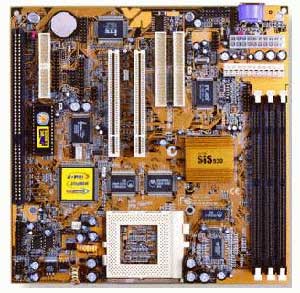
Year:
Type: Socket 7
Form Factor:
Chipset: SiS 530
Slots:
This motherboard often had its chipset relabelled to "SX Pro", but is in fact an SiS 530.
User manual (non-LMR), User manual (LMR) |
M599 / Matsonic MS-6380SG / M599LMR
Year:
Type: Socket 7
Form Factor: uATX
Chipset: SiS 530
Slots:
Known Revisions: 1.4
This motherboard often had its chipset relabelled to "SX Pro", but is in fact an SiS 530. |
M601
Year: 1993
Type:
Form Factor:
Chipset: SARC RC4018A4
Memory: 8 x 30-pin SIMM
Slots: 7 x ISA (16-bit), 3 x VLB
BIOS: AMI or Award v4.50
BIOS Strings:
40-0100-001437-00101111-080893-4386-F
40-0101-001437-00101111-080893-UMC491-F
1990 Pheonix Technologies S-B16-V16-Foff
Known Board Revision: 1.3
This board accepts any Intel, AMD or Cyrix 486 CPUs up to 66 MHz. 64 KB up to 256 KB of cache RAM
This motherboard often had its chipset relabelled to "BXcel", but is in fact an ALi M1621 (Aladdin Pro II). |
M726 / Amptron PII-3726
Year: ?
Type:
Form Factor:
Chipset: ALi Aladdin Pro II.
This motherboard often had its chipset relabelled to "BXcel", but is in fact an ALi M1621 (Aladdin Pro II).
User manual
|
M727
Year: ?
Type:
Form Factor:
Chipset: ALi Aladdin Pro II.
This motherboard often had its chipset relabelled to "BXcel", but is in fact an ALi M1621 (Aladdin Pro II).
|
M729
Year: ?
Type:
Form Factor:
Chipset: ALi Aladdin Pro II.
This motherboard often had its chipset relabelled to "BXcel", but is in fact an ALi M1621 (Aladdin Pro II).
User manual
|
M730
Year: ?
Type:
Form Factor:
Chipset: VIA Apollo Pro.
This motherboard often had its chipset relabelled to "BXpert", but is in fact a VIA Apollo Pro.
User manual |
M741 / Amptron PII-3741
Year: ?
Type:
Form Factor:
Chipset: SiS 620.
This motherboard often had its chipset relabelled to "Xcell 2000", but is in fact an SiS 620.
User manual (LMR version)
|
M747 / Amptron PII-3747
Year: ?
Type:
Form Factor:
Chipset: SiS 5600.
This motherboard often had its chipset relabelled to "BX Pro", but is in fact an SiS 5600.
User manual
|
M748 / Amptron PII-3748
Year: ?
Type:
Form Factor:
Chipset: SiS 620.
This motherboard often had its chipset relabelled to "Xcell 2000", but is in fact an SiS 620.
|
M754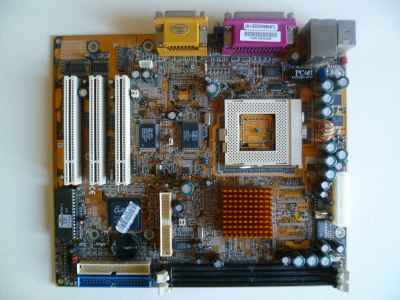
Year: ?
Type:
Form Factor:
Chipset: ALi Aladdin TNT2.
Known Revisions: v1.5B
This motherboard often had its chipset relabelled to "GFXpro" or "GFXcel", but is in fact an ALi M1631 (Aladdin TNT2). |
M755
Year: ?
Type:
Form Factor:
Chipset: SiS 630.
This motherboard often had its chipset relabelled to "GFXcell", but is in fact an SiS 630. |
M756
Year: ?
Type:
Form Factor:
Chipset: SiS 630.
This motherboard often had its chipset relabelled to "GFXcell", but is in fact an SiS 630. |
M757
Year: ?
Type:
Form Factor:
Chipset: SiS 630.
This motherboard often had its chipset relabelled to "GFXcell", but is in fact an SiS 630. |
M758
Year: ?
Type:
Form Factor:
Chipset: SiS 630.
This motherboard often had its chipset relabelled to "GFXcell", but is in fact an SiS 630.
User manual |
M760 / Amptron PII-3760
Year: ?
Type:
Form Factor:
Chipset: VIA Apollo Pro+.
This motherboard often had its chipset relabelled to "BX Too", but is in fact a VIA Apollo Pro+.
User manual (760-14), User manual (760-V12w), User manual (760-V14)
|
M761 / Amptron PII-3200
Year: ?
Type:
Form Factor:
Chipset: VIA Apollo Pro.
This motherboard often had its chipset relabelled to "BXpert", but is in fact a VIA Apollo Pro.
User manual (v11a)
|
M762
Year: ?
Type:
Form Factor:
Chipset: VIA Apollo Pro.
This motherboard often had its chipset relabelled to "BXpert", but is in fact a VIA Apollo Pro.
User manual |
M765
Year: ?
Type:
Form Factor:
Chipset: VIA Apollo Pro.
This motherboard often had its chipset relabelled to "BXpert", but is in fact a VIA Apollo Pro.
User manual |
M767
Year: 1998
Type: Super Socket 7
Form Factor:
Chipset: VIA Apollo Pro+.
Known Revisions: 1.3,
This motherboard often had its chipset relabelled to "BX Too", but is in fact a VIA Apollo Pro+.
User manual (v1.3), User manual (V13) |
M810 / Matsonic MS8308E / ECS K7SEM
Year: ?
Type:
Form Factor:
Chipset: SiS 730S
This motherboard often had its chipset relabelled to "T-Bird", but is in fact an SiS 730S. |
M919
Year: 1994/1995
Type: Socket 3
Form Factor: Baby AT
Chipset: UMC 8881B/E
Memory: 4 x 30-pin SIMM slots (1 bank), 2 x 72-pin SIMM (1 bank).
Slots: ISA (4 x 16-bit), VLB (1), PCI (3)
Known Revisions: 3.4B, 3.4F
Known BIOS Strings:
41-P400-001437-00101111-101094-486AVIP (with BIOS date 6 May 1996)
41-P400-001437-00101111-101094-486AVIP (with BIOS date 15 Sep 1996)
41-P400-001437-00101111-101094-486AVIP (with BIOS date 16 Oct 1996)
Despite the fact this board has the highly publicised fake cache chips (see top-right corner), it's still an interesting one in that it has a combination of ISA, VESA Local Bus, and PCI slots. There is an argument that combining VLB and PCI on the same board is a bad design choice due to the differences in frequency that are supported between these two standards. Some have noticed the presence of VLB slots on boards like this slows down the PCI slots to avoid incompatibility.
The M919 is also a flexible board memory-wise, with both 30-pin and 72-pin SIMM slots. The latter accepts either Fast Page Mode (FPM) or Extended Data Out (EDO) SIMMs. Note that only boards with the UM8881E or UM8881F can use EDO memory - the older UM8881B cannot. If configuring for EDO RAM, you must specify the DRAM Type as 'EDO' in the BIOS. It can take a total of 256 MB of memory.
It also has a COAST slot to 'expand' the level 2 cache, populated in the pictured board on the middle-right above the CPU socket (Actually it's not a standard COAST slot! Be warned this slot only support PC Chips proprietary cache modules - apparently the pinouts are different so you may damage a standard COAST SRAM card or your motherboard if you use it in this board!!). The user manual indicates modules were in sizes of 128 KB, 256 KB, 512 KB and 1 MB, and that initially only asynchronous SRAM versions were available but they would be releasing pipeline burst SRAM modules at a later date. Furthermore, these cache modules came in both 3.3V processor and 5V processor versions (configured via JP4 and JP5 A-D - see manual for settings) - modules with model M919-01S3 are the 3.3V ones and model M919-02S5 are the 5V ones. They will only work with processors of the same voltage as the cache module. My cache card is the asynchronous type with nine Alliance Semiconductor AS7C256-15JC ICs, meaning it's a 256 KB module.
Because the actual level 2 cache chips are simply black squares of plastic, it's a slightly redeeming fact they included this so you can at least have some level 2 cache if you put an SRAM cache card in this slot.
The board does FSB/2 automatically for the PCI bus if FSB is higher than 33 MHz. VLB always runs at the FSB speed.
Apparently the chipset can get hot when running FSB > 33 MHz. Consider a heatsink if doing so.
Revision 3.4 B/F didn't have the fake cache chips - they had no cache unless you installed a PC Chips-compatible cache module. Performance of the M919 with a 256 KB cache module installed is on par with the Biostar MB-8433UUD motherboard with which it shares the same chipset.
Another interesting thing about the M919 is that it's one of the only Cyrix 5x86-supporting motherboards that has several feature-enabling options directly within the BIOS for this CPU range - they are Linear Burst Mode and Load Store Reordering. For the other many performance-enhancing features of the 5x86, you would need to use one of the Cyrix 5x86 utilities.
The M919 was also sold as the Amptron DX9700.
User Manual
|
M921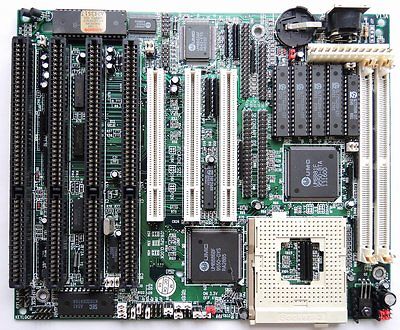
Year:
Type:
Form Factor:
Chipset: UMC 8881
Slots: ISA, PCI
Has the fake level 2 cache.
Supports the following CPUs: Intel 486DX/DX2/DX4, P24T, IBM/Cyrix Cx486DX and DX2 (M7), DX4, and Cx5x86, AMD Am486DX2, DX4, and AMD K5. Clock speeds from 25 MHz up to 133 MHz. |
M922
Year:
Type:
Form Factor:
Chipset: ?
Slots: |
M935
Year:
Type:
Form Factor:
Chipset: ?
Slots: |
 PC Chips Motherboards
PC Chips Motherboards



























